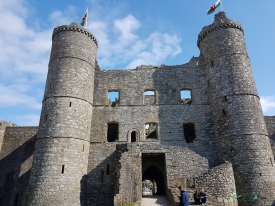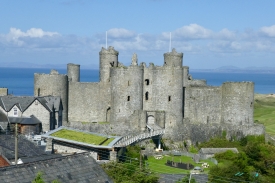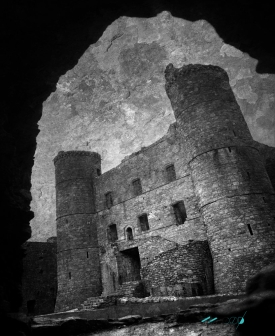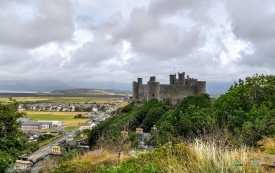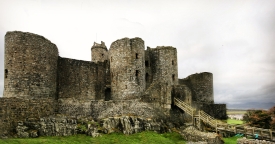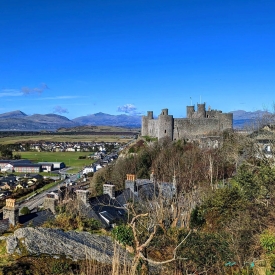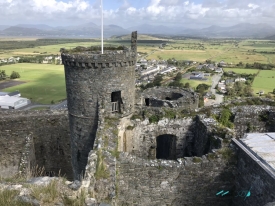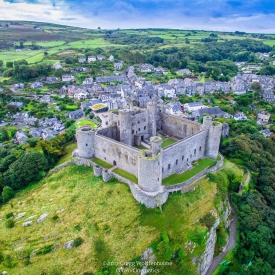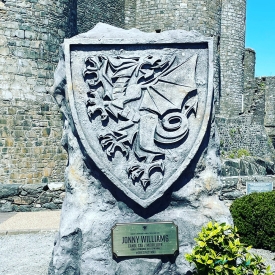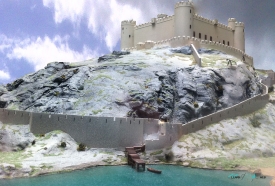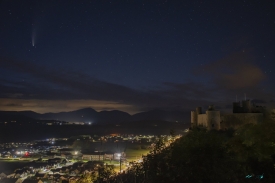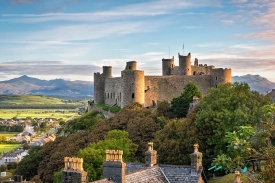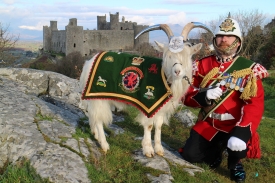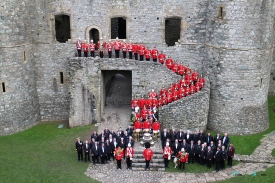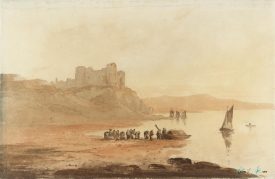Harlech Castle is a medieval castle in Harlech, Gwynedd. It was built by Edward I between 1282 and 1289. It is one of four concentric castles, namely Caernarfon, Beaumares and Conwy, that were built after the campaign of 1282. The strength of the concentric castles was the two walls, that is, the outer wall and the inner wall. These fortress castles were designed based on the architecture of the forts built by the Crusaders in the Middle East.
The castle played an important role in Welsh history in the following centuries.
In 1294, Madog ap Llywelyn started a rebellion against the English that quickly spread throughout Wales. The rebels besieged Harlech Castle that winter. Fresh supplies were shipped from Ireland by sea and transported through the floodgates of Harlech ending the rebellion.
During Owain Glyn Dŵr's rebellion in 1403, only a handful of castles, including Harlech, managed to hold their own against the rebels. There was not enough equipment or personnel in the castle to withstand a siege and records show that the garrison only had three shields, eight helmets, six spears, ten pairs of gloves and four weapons. By the end of 1404, the castle had fallen to Glyn Dŵr and became his home and military headquarters for four years. In 1408, English forces, under the authority of the later crowned Henry V and his commander, Edmund Mortimer, laid siege to the castle. Artillery and cannons did extensive damage to the southern and eastern parts of the outer walls. After failing to capture the castle, Henry left John Talbot in charge of the siege and Henry made his way to Aberystwyth Castle. After Mortimer and many of his men died of exhaustion, Harlech finally fell in February 1409.
In the 15th century, Harlech Castle was involved in a series of civil wars, known as the Wars of the Roses, between hostile factions of the Lancaster family and the York family. In 1460, after the Battle of Northampton, Queen Margaret of Anjou and her baby, Prince Edward, fled to the castle. Between 1461 and 1468 it was in the hands of supporters of the Lancaster family, under the authority of Dafydd ap Ieuan. Due to its natural defenses and supply route by sea, Harlech Castle once again held its own and, when other castles fell, it was the last of the major strongholds still under the control of the Lancastrian family. The song Rhyelghyrgh Gwwr Harlech refers to a siege at that time.
The castle became a base for his campaigns throughout the region. Sir Richard Tunstall attacked from Harlech Castle in 1466, and Siaspar Tudur, Henry Tudor's uncle, landed there with additional troops from France in 1468. Following Siaspar Tudur's arrival, Edward IV ordered William Herbert to raise an army, possibly up to 10,000 men, though on order. to capture the castle once and for all. After a month, the garrison surrendered on August 14.
After the start of the English Civil War in 1642, the castle was captured by forces loyal to Charles I. The castle had not been repaired after the 1468 siege and was in disrepair, with the exception of the gatehouse, which it was used as the local court. In 1644 Rupert, Prince of the Rhine appointed Colonel William Owen as bailiff of the castle, and Colonel Owen was given the task of repairing the fort. There was a long siege between June 1646 and March 1647 when the 44-man garrison surrendered to General Thomas Mytton. The castle was the last royal fortress on earth to surrender, marking the end of the first phase of the war.
The castle is today in the care of Cadw, the Welsh government institution that preserves Welsh heritage. The castle was placed on the UNESCO World Heritage List in 1986, as part of King Edward's Castle and Wall Ensemble in Gwynedd.
The castle played an important role in Welsh history in the following centuries.
In 1294, Madog ap Llywelyn started a rebellion against the English that quickly spread throughout Wales. The rebels besieged Harlech Castle that winter. Fresh supplies were shipped from Ireland by sea and transported through the floodgates of Harlech ending the rebellion.
During Owain Glyn Dŵr's rebellion in 1403, only a handful of castles, including Harlech, managed to hold their own against the rebels. There was not enough equipment or personnel in the castle to withstand a siege and records show that the garrison only had three shields, eight helmets, six spears, ten pairs of gloves and four weapons. By the end of 1404, the castle had fallen to Glyn Dŵr and became his home and military headquarters for four years. In 1408, English forces, under the authority of the later crowned Henry V and his commander, Edmund Mortimer, laid siege to the castle. Artillery and cannons did extensive damage to the southern and eastern parts of the outer walls. After failing to capture the castle, Henry left John Talbot in charge of the siege and Henry made his way to Aberystwyth Castle. After Mortimer and many of his men died of exhaustion, Harlech finally fell in February 1409.
In the 15th century, Harlech Castle was involved in a series of civil wars, known as the Wars of the Roses, between hostile factions of the Lancaster family and the York family. In 1460, after the Battle of Northampton, Queen Margaret of Anjou and her baby, Prince Edward, fled to the castle. Between 1461 and 1468 it was in the hands of supporters of the Lancaster family, under the authority of Dafydd ap Ieuan. Due to its natural defenses and supply route by sea, Harlech Castle once again held its own and, when other castles fell, it was the last of the major strongholds still under the control of the Lancastrian family. The song Rhyelghyrgh Gwwr Harlech refers to a siege at that time.
The castle became a base for his campaigns throughout the region. Sir Richard Tunstall attacked from Harlech Castle in 1466, and Siaspar Tudur, Henry Tudor's uncle, landed there with additional troops from France in 1468. Following Siaspar Tudur's arrival, Edward IV ordered William Herbert to raise an army, possibly up to 10,000 men, though on order. to capture the castle once and for all. After a month, the garrison surrendered on August 14.
After the start of the English Civil War in 1642, the castle was captured by forces loyal to Charles I. The castle had not been repaired after the 1468 siege and was in disrepair, with the exception of the gatehouse, which it was used as the local court. In 1644 Rupert, Prince of the Rhine appointed Colonel William Owen as bailiff of the castle, and Colonel Owen was given the task of repairing the fort. There was a long siege between June 1646 and March 1647 when the 44-man garrison surrendered to General Thomas Mytton. The castle was the last royal fortress on earth to surrender, marking the end of the first phase of the war.
The castle is today in the care of Cadw, the Welsh government institution that preserves Welsh heritage. The castle was placed on the UNESCO World Heritage List in 1986, as part of King Edward's Castle and Wall Ensemble in Gwynedd.



